Intricate and easy to make shawls, as an accessory on the shoulders, have always given the image of natural sophisticated femininity. Knitting a shawl with knitting needles will not be difficult if you decide on the model and understand the knitting instructions with a diagram and description. Even a beginner knitter can do it. The asterisks in the headings indicate the complexity of the work.
Simple shawl with knitting needles*
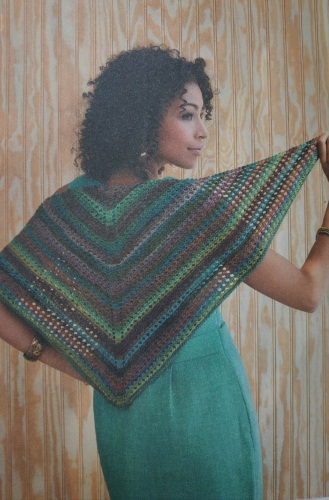
This light multi-colored shawl is very easy to knit. You can use single-color yarn, melange, sectional dyeing, 2-5 colors.
Materials and tools
- Yarns Alpaca Sox, 2 skeins of 100 g.
- 3.5mm knitting needles with long cord for knitting in the round to hold a large number of stitches.
- 2 markers for marking the center of the product.
Getting Started
The shawl is knitted from the middle of the long side down and to the sides. You need to knit a ribbon of 3 loops and 7 rows. Along the edge and bottom, dial 6 more. You get 9 loops.
Description
- You need to take the shawl according to the pattern.
- In the front rows, add yarn overs according to the pattern.
- Knit all purl rows.
- Knit the product to the desired size.

- Finish with 4 rows of knit stitches.
- Steam the finished shawl.
Openwork shawl**
This easy to make lace shawl is knitted from the central corner. As you knit it, it widens due to the yarn overs.
Materials and tools
- The yarn that is suitable is not prickly, 150 g Yarns MountainTop Vail (alpaca, viscose, bamboo), cream, sand or beige.
- Circular knitting needles, size 3-4 mm, with a cable length of 80-120 cm.
Description of knitting
The diagram shows only the odd rows of the shawl. In the even rows, the stitches are knitted purlwise.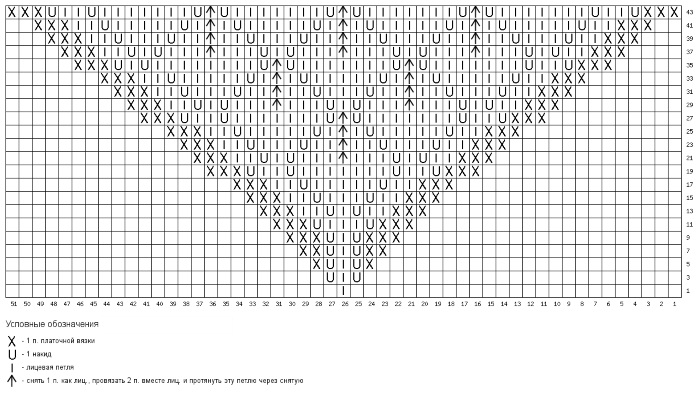
- Cast on 3 stitches on both knitting needles: 2 stitches for the edge and 1 for the main pattern.
- Next, you should knit according to the pattern.
- The knitting is finished with garter stitch (4 rows), that is, the loops are knitted as front loops.
- Close the loops tightly using any known method.
- If desired, a border can be knitted along the three short sides.
- The product needs to be steamed with an iron. You can also soak it in a soap solution, rinse it and let it dry in an unfolded form.
Holden**
Shawl with knitting needles, the diagram and description of it are given below, is knitted from the center of the longest edge. First, the shawl is knitted with a simple stocking stitch with increases along the edges and the center. 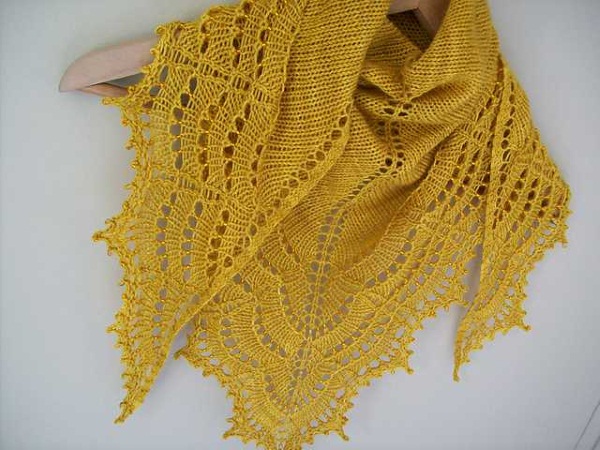 The "Holden" pattern is used to decorate the openwork edge of the product. And the shawl is finished with a "picot" trim.
The "Holden" pattern is used to decorate the openwork edge of the product. And the shawl is finished with a "picot" trim.
Materials and tools
- Circular knitting needles, size 3-4 mm, with a length of about 80 cm.
- The yarn is thin, preferably natural – wool, mohair. You can add silk thread for strength. One skein is enough for a baktus, and for a full shawl you need 2-3 skeins of 100 g.
- Markers for indicating increases.
- Beads, if used, must first be strung onto the yarn. They should pass freely through the thread.
Beginning of knitting a shawl
To avoid a large hole forming in this place, you need to start by knitting the so-called ribbon. It consists of 2 loops of the cast-on row. A ribbon of 5 rows is knitted from them. Then 3 loops are cast on along the long edge and 2 more along the second edge. As a result, there are 7 loops on the needle to start knitting.
Stocking stitch (front stitch)
The front side is knitted with knit stitches. The back side is knitted with purl stitches.
Job Description
- From here on the first 2 and last 2 loops are garter stitches. So the ribbon will continue along the entire length of the product. The central loop (it is better to mark it with a marker) is highlighted with yarns in the front rows. This is how the expansion along the central part is obtained.
- The increases on the sides of the shawl can be done in any way:
- yarn overs after the first two loops of the ribbon and before the last two;
- by knitting two loops from one loop behind the front and back wall.
- The shawl is knitted in stocking stitch, with increases on the sides and in the center to the desired size.
- The Holden pattern is simple. It combines knit stitches, yarn overs, and stitches knitted together to the left or right.
Designations:
- - front loop on the wrong side;
○ — yarn over;
/ - 2 together one, tilt to the right;
\ — 2 loops of one, tilt to the left.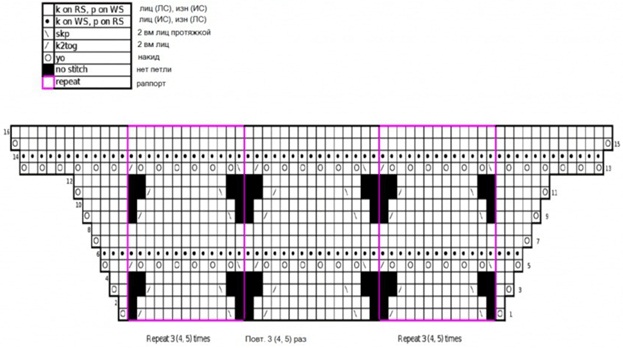
Black cells mean that there is no loop. White cells are stocking stitch. The purple color outlines the areas of the pattern adjacent to the shawl extensions. The rapport in the center is repeated as many fans as there are. It is knitted straight without changes.
The diagram shows one half of the triangle without the central loop with increases and the side strip with increases. That is, you need to knit as before, only instead of the stocking part, beautiful fans are knitted.
Pico
The knitting of the shawl is completed by closing the loops with a "picot". The tooth is formed by knitting from one loop on the right needle another one, as in crocheting, and again. The last loop is closed by inserting the left needle into the base of the picot and pulling out another loop from it.
It is pulled through this loop on the right knitting needle. That's it, the tooth is ready. There can be any number of closed loops between the picots. The main thing is that they are distributed at equal intervals. At the end, cut the thread, hide the end in the product.
End of work
The shawl should be washed in shampoo or other mild detergent. Then lightly squeezed, wrapped in a towel. The knitting should be dried in a straightened form on a large flat surface covered with a clean cloth.
Peacock tail***
The rectangular shawl is knitted from the middle to both sides. The pattern consists of 3 parts. In the center are small diamonds, turning into feathers, which become larger towards the ends.  Dimensions 0.5x2 m. The product is worn as a headscarf, shawl and stole on the shoulders. The model looks great in white, beige and black.
Dimensions 0.5x2 m. The product is worn as a headscarf, shawl and stole on the shoulders. The model looks great in white, beige and black.
Materials and tools
- Needles size 2.5 mm.
- Thin yarn, mohair, alpaca, about 4 skeins of 50 g.
Job Description
- Cast on 111 stitches using the extra yarn in the usual way and knit as shown in diagram 1. Then move to diagram 2 and finish knitting according to diagram 3.
- To knit the second part of the stole, unravel the extra thread. Cast on the opened loops onto the knitting needles and continue knitting, again starting with diagram 1, then diagrams 2 and 3.
- When finished, wash the product by hand, wring it out, and wrap it in a towel.
- Dry in a straightened form on a flat surface.
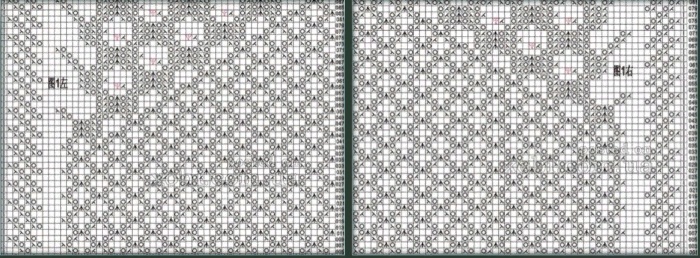 Scheme 1
Scheme 1
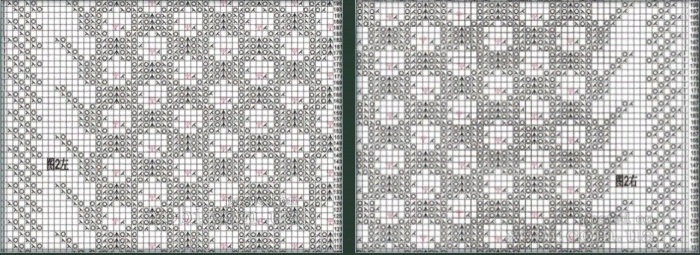
Scheme 2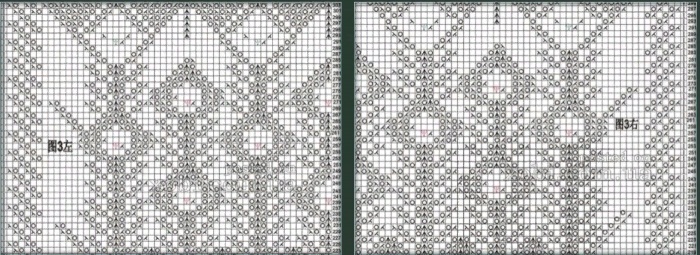
Scheme 3
Wingspan*
The shawl is unusual, original, asymmetrical. It looks good knitted with sectional yarn. The simple design consists of 8-12 triangles, which are knitted one on top of the other using shortened rows.
Materials and tools
- Medium thickness yarn, wool or merino with nylon, 100 g.
- Knitting needles, size 3.5 mm on 60 cm line.
- Markers.
Job Description
- Throughout the work, knit with face loops. To knit the first triangle, you need to cast on 90 loops and complete 1 row.
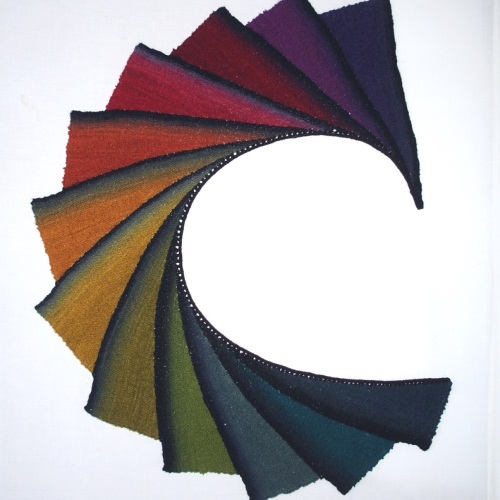
- In the 2nd row, remove the edge loop, 2 front loops, place a marker, then knit to the end.
- In the 3rd row, remove the edge stitch and knit to the marker. Remove it, turn the work.
- In the 4th row, remove the edge stitch, knit 2, place a marker, continue knitting to the end.
- In this way, you need to knit until there are no working loops left and there is nowhere to put the marker.
- Knit in the opposite direction, not reaching the end of the row, 16 loops. Place a permanent marker, it will show the beginning of a new triangle. Turn knitting.
- A new triangle begins. Remove the edge stitch, 2 knit stitches, insert a moving marker, then knit. Now cast on 16 new stitches using any known method. Turn the work.
- Edge, then knit to the moving marker. Remove it, turn the knitting.
- Slip edge stitch, knit 2, place marker, continue knitting. Repeat steps 8 and 9 until there are no stitches left in the work. Then move on to steps 6, 7, 8 and 9.
- When all triangles are knitted, knit 4 rows along the inner edge, removing markers as you go.
- Steam the product and dry it on a flat surface.
Drops of dew***
The shawl is basically a simple stocking stitch. The openwork pattern is knitted as a beautiful wide border.  Here, only yarn over increases are made near the central loop on both sides and one at each edge of the product.
Here, only yarn over increases are made near the central loop on both sides and one at each edge of the product.
Materials and tools
- Merino yarn with silk, wool with silk, type Kauni, 150 g.
- Knitting needles with a line of at least 80 cm, size 3.5-3.75 mm.
- Markers for convenience.
Job Description
- The main knitting is stocking stitch (face stitch), that is, with knit stitches on the face side and purl stitches on the back side.
- Knitting begins with 3 loops. A small ribbon is knitted from them in 7 rows. Then 3 loops are picked up along the long side and 3 along the edge. In total, there are 9 loops on the knitting needle.
- Pattern 1 can be repeated several times to the desired size, the main thing is that the number of rows is divisible by 8.
- Patterns 2-6 are knitted once. Rapports are highlighted in red.
- Finish the product with a border (diagram 7).
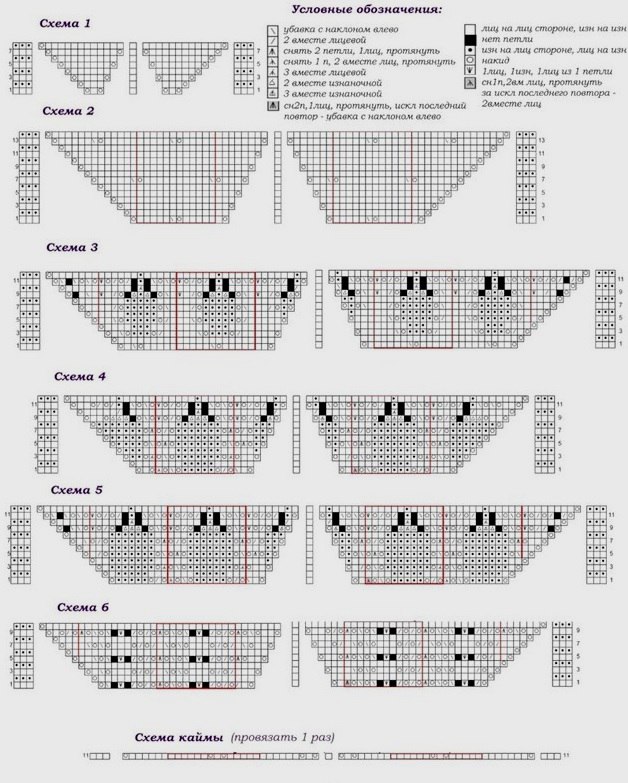
Shawl with knitting needles drops of dew. Scheme and description - Soak the shawl in a solution with shampoo, then rinse. Then wrap the product in a towel and wring it out. Knitting should be dried in an unfolded form.
Orchid**
The shape of the item resembles a large asymmetric fan. It consists of 5 fragments, which are knitted with garter stitch. Each segment is knitted from the previous one. Between them there is an openwork strip. The shawl looks complicated, but the execution is simple, based on knitting shortened rows. It looks wonderful if made from sectionally dyed yarn.
Materials and tools
- Yarn Kauni, Alize or Alpina Romantic 300 g, dyed in long sections.
- Circular knitting needles with long cable 100 cm, size 4.75 mm.
- Crochet hook
- Decorative buckle.
Openwork strip
In the 1st row, 2 knit stitches are knitted one to the left, yarn over.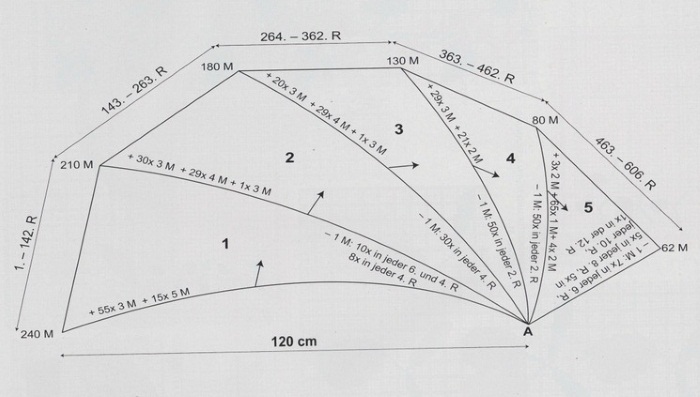
In the 2nd row - knit stitches.
Job Description
- Cast on 240 stitches. Knit the first 2 rows with the front stitches. Shortened rows begin with the 3rd row. On the left side, add 55x3 stitches and 15x5 stitches. On the right side, decrease 10x1 stitch through the 5th and 3rd rows. To do this, knit the first 2 stitches (from the edge stitch) as one stitch up to the 110th row. Then, in the 111th–142nd rows, do this decrease 8 times through the 3rd row in the fourth row. Finish the segment with an openwork stripe (rows 141st and 142nd).
- There are 210 loops on the knitting needles. On the left side, add 30x3 loops, then 29x4 loops, 1x3 loops. On the right edge, decrease 30 times, 1 every 3 rows. Finish with an openwork strip (rows 262 and 263).
- There are 180 loops on the knitting needles. On the left side, add 20x3 loops, 29x4 loops and 1x3 loops. On the right side, at the same time, you need to decrease 50 times by 1 loop every other row. Finish the segment with an openwork strip (rows 361 and 362).
- There are 130 loops on the knitting needles. On the left, add 29x3 loops, 21x2 loops. On the right, decrease 50x1 loop every other row. The openwork stripe is knitted on rows 461 and 462.
- There are 80 loops on the needles. On the left, you need to add 3x2 loops, 65x1 loop, 4x2 loops. On the right side, shorten 7x1 loop every 6 rows, 5x1 loop after 7 rows, 5x1 loop after 9 rows, 1 time after 11 rows. Knit the last 62 loops with an openwork strip and close very loosely.
Crochet edging
- Tie the cast-on edge and the shawl along the perimeter with sc. Row 2 - 1 sc, *skip 1, 2 sc in one, 1 ch, 2 sc*. Alternate from * to * along the entire length.
- Tie the bottom edge with sc with 1 ch between them. In the 2nd row, tie 1 sc, *through one arch into the second, tie a fan of 1 dc (with a yarn over), 1 ch, 1 column with 2 yarn overs, 1 ch, 1 dc. Then skip 1 ch, tie 1 sc*. Tie the entire bottom edge in this way, repeating between **.
Frozen Leaves***
Shawl with knitting needles, the scheme and description of which corresponds to a triangular shape. Start knitting from the center of the largest side. The pattern consists of three parts. First, the main pattern "frozen leaves", then "diamonds", the final part is the border. Sometimes the border is not knitted, the shawl does not lose from this.
Materials and tools
- Suitable yarn: mohair, angora and wool. It should be soft and not prickly, since the shawl is worn near the face and neck. When buying, you should apply the skein to these sensitive areas and check.
- Needles are circular, size 3.5-4.5. Knitting is not in a circle, but it is convenient to hold a large number of loops on them. To prevent loops from getting stuck during work, the fishing line should be attached end-to-end, and the needles themselves should be metal with a shiny smooth coating. The product does not slide well on wooden and aluminum needles.
- To close the loops at the end of the work, it is convenient to use a 3.5 mm thick crochet hook.
- Multi-colored markers or small loops of contrasting colored thread.
- The row counter (optional) is attached to the knitting needle.
- Pearl beads or seed beads.
Knitting pattern and description
The diagram of the right half of the shawl shows the odd rows. The row begins with an edge loop, it is always removed without knitting. Then 2 garter loops and then knit according to the pattern from right to left. Having reached the leftmost front loop, the pattern is repeated in the opposite direction. This is how the left half of the product is obtained. At the end of the row - 2 garter loops and a purl edge loop.
The red color indicates the beginning of knitting a new leaf. Black cells are not knitted - this is the designation of the borders of each leaf. A marker is placed in this place.
Right half diagram
Designations:
- - facial;

○ — yarn over;
/ - 2 together, tilt to the right;
\ — 2 together, tilt to the left;
⊻ — edge;
⩚ — three loops in one.
- Start with 3 cast-on loops, knit 5 rows with the front loops. Then cast on 4 loops from the sides, so that there are 7 loops in total. This is the beginning of knitting. Then knit according to the pattern. Otherwise, the first rows can be obtained if you immediately cast on 7 initial loops, knit 3 rows and proceed to making the pattern.
- All purl rows are knitted with purl stitches, but the first 2 and the last 2 - before and after the edge ones - are knit stitches. They are knit stitches in all rows. The central stitch is marked with markers on both sides (colored stitches) for orientation.
- The shawl is expanded by knitting new leaves. The pattern is repeated from rows 19 to 31. Having knitted 5-7 full leaves in the center, we knit only up to row 29 for the last time. And then we need to move on to making the transitional pattern.

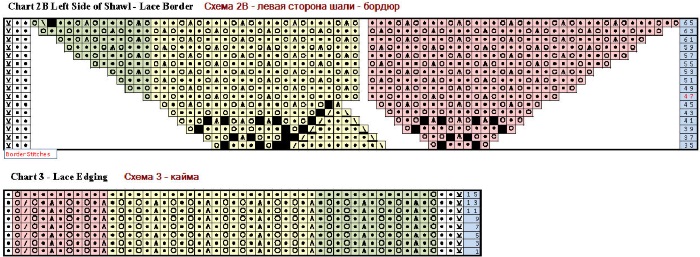
- Patterns 2A and 2B are the right and left sides of the shawl, which are knitted after the transition pattern. The pattern is marked in yellow and is repeated several times. Before the middle of the shawl, there are 3 loops left, which are knitted along the pink part of the pattern. Then the central loop is knitted, and we move on to the pink part of pattern 2B for the left side of the shawl. The yellow rapport is done several times until the last three edge loops.
- The shawl border is knitted according to pattern 3. But you can leave the knitting as is.
Finishing knitting and processing the product
The loops are closed in the usual way, not tightly. The shawl needs to be soaked in a soap solution, it is better to take shampoo or liquid soap. If the yarn is still prickly, add a rinse or hair balm.
Leave to soak well for half an hour. Then take the product out, wrap it in a towel and squeeze it out slightly. Cover a large flat surface with a blanket, then a sheet on top. Lay out the shawl on it and carefully straighten it out. Pin the corners and leave to dry.
Sultan***
The shawl with the Sultan pattern is knitted from thin yarn, beautiful sectional dyeing or plain. Knitting starts from the center and evenly expands around the entire circumference. The edge of the product is closed with a hook.
Materials and tools
- Yarn Alize Real, Kauni, wool with acrylic 40/60, 200 g.
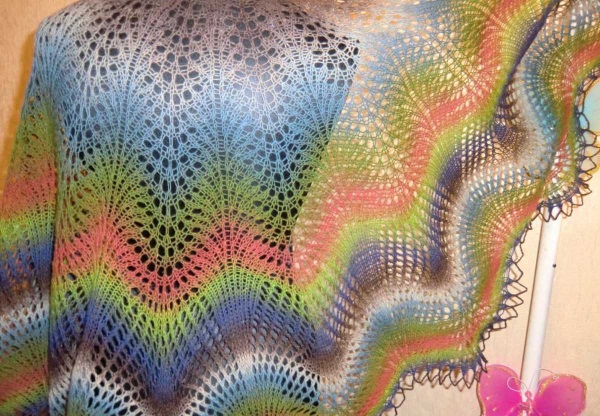
- Circular knitting needles size 3 mm.
- Crochet hook number 3.
- Markers for indicating rapports.
Job Description
This shawl does not have edge loops as such. At the beginning and at the end of the product, 2 front loops are knitted at once, which are then done with garter stitch. Up to the 7th row, increases are made by pulling the loop from the bottom row (1B).
- Cast on 6 stitches. Continue knitting as follows: 2 knit stitches, 1B, 2 knit stitches, 1B, 2 knit stitches.
- The loops are knitted.
- 2 garter stitches, 1B, 4 knit stitches, 1B, 2 garter stitches (10 loops).
- 2 garter stitches, 6 purl stitches, 2 garter stitches.
- 2 garter stitches, 1B, 2 knit stitches, 1B, 2 knit stitches, 1B, 2 knit stitches, 1B, 2 garter stitches (14 stitches).
- 2 garter stitches, 10 purl stitches, 2 garter stitches.
- 2 garter stitches, *yarn over, 1 knit stitch*, repeat 10 times, end with yarn over, 2 garter stitches.
- All paired rows are purl according to the pattern, taking into account 2 garter stitches on the sides.
- Repeat the pattern marked in pink 21 times.
- Repeat the blue stitches until you have the number of stitches shown on the diagram on the left. Knit them according to the black and white pattern. Repeat the yellow pattern until you have the last 2 garter stitches.
- Once scheme 1 is completed, you should move on to scheme 2.
- In row 27, the needles can be changed to slightly larger 3.75 mm. In row 63, to 4.25 mm.
Scheme 1
Scheme 2
To finish knitting the shawl, you need to take a hook.
Knitting instructions:
- From 3 loops on the knitting needle, pull out one, then 9 air loops.
- The motive is to continue in the outer circle until the end.
- Then turn the shawl over.
- Start with 3 sc in a chain, *9 ch, 1 sc under the arch from the bottom row*.
- Then make a pattern between the stars along the entire circumference.
- The finished shawl needs to be steamed, unfolded, pinned and dried.
Dancing Butterflies***
The shawl with knitting needles, the diagram and description, shown here is a crescent. In the center the height is 50 cm, along the long side - 160 cm. 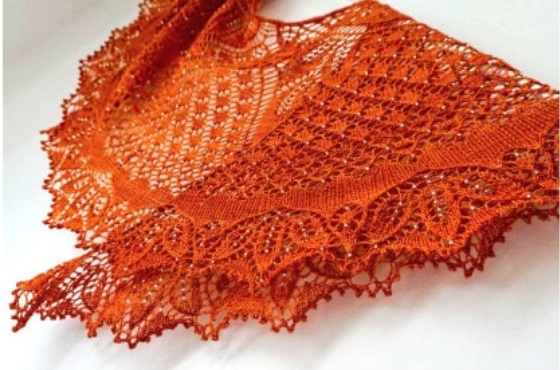 The product looks beautiful with a single-color thread, not too fluffy to show the pattern.
The product looks beautiful with a single-color thread, not too fluffy to show the pattern.
Materials and tools
- Yarn Sock Malabrigo, 150 g.
- Needles for knitting in the round size 3.75 mm. Knit in forward and reverse directions.
- Markers.
- Japanese beads Toho Hexagon 6. String them on a thread beforehand. You will need about 830 pieces.
Job Description
- You need to start by knitting a small ribbon. Knit three loops of the initial row 58 times as front loops. Turn the ribbon and cast on 29 loops along the long side and pull out 3 more loops from the cast-on row. You will get a total of 35 loops. The first and last 3 loops of these will be edge loops.
- Proceed to knitting according to the patterns. Purl loops are knitted on the wrong side, excluding edge loops and those marked OO and OOO.
- Perform pattern 1 twice, then knit the central pattern 2. Perform pattern 3 also 2 times.
- From rows 73 to 96 the pattern changes and is knitted according to patterns 4.
- The final part is knitted according to patterns 5. Here the difference between the patterns is that the first one is closed with picot teeth. The second pattern is for closing with a crochet hook. A group of 5 loops is knitted as one, 11 air loops are knitted 5 times. Then 3 loops are knitted together and 11 air loops are repeated 16 times. And so they knit further according to the pattern.
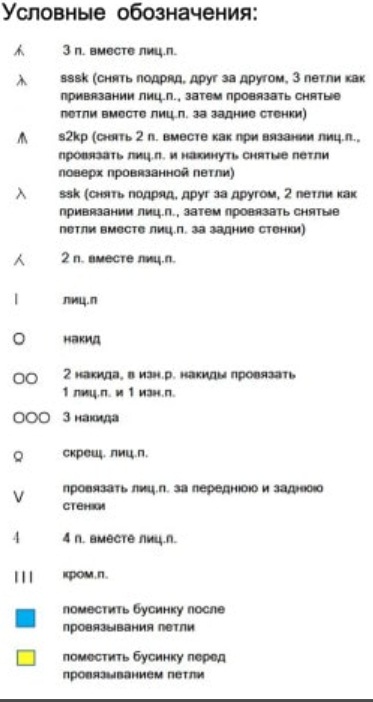
Scheme 1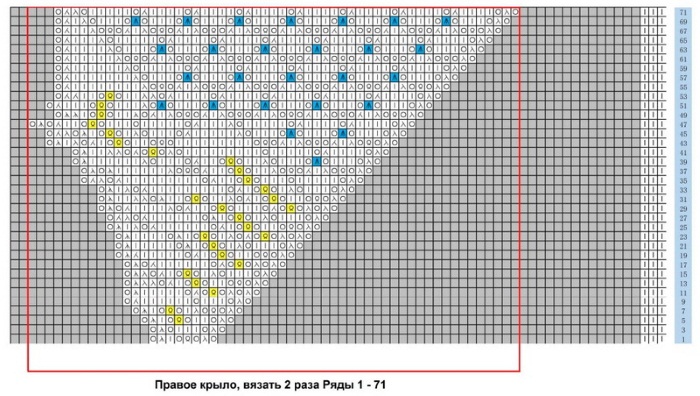
Scheme 2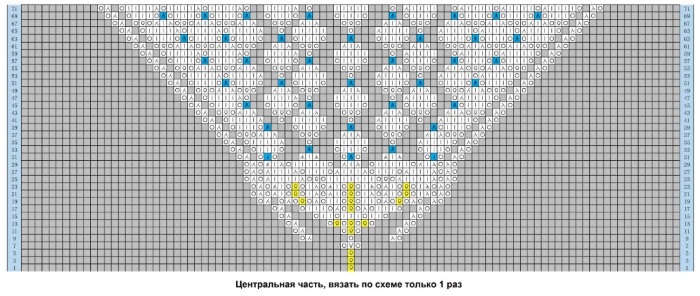
Scheme 3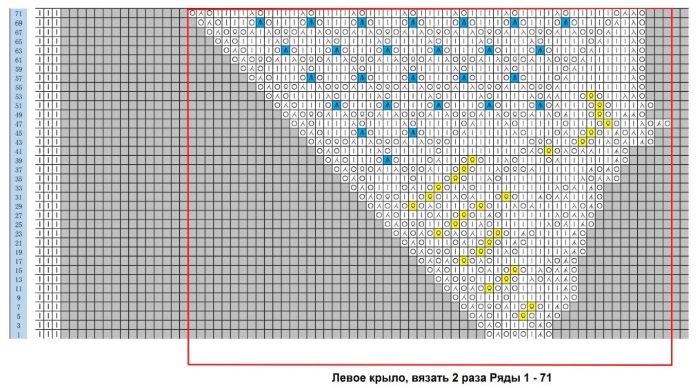
Schemes 4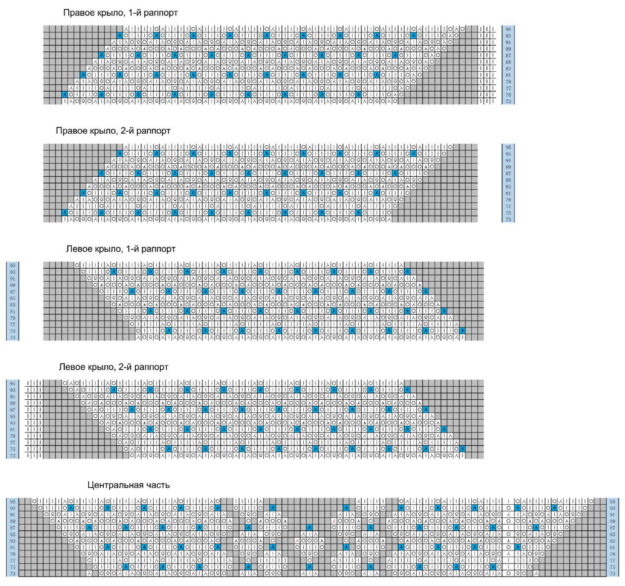
Schemes 5
Lace shawl**
An interesting lace shawl consists of several patterns: garter stitch, openwork pattern and the pattern shown in the diagram.
Materials and tools
- Thin yarn 100 g (alpaca, bamboo, viscose), light colors.
- Knitting needles for knitting in the round, size 4 mm.
Openwork pattern
- Edge, yarn over, 2 loops of one knit stitch.
- Paired rows are knitted purlwise.
- Edge, one front 2 loops, yarn over.
Job Description
Cast on 284 stitches onto the knitting needles. Knit 4 rows as front stitches.
- Edge, 1 knit stitch, then *knit stitches to the rapport, knit the rapport of 22 stitches 5 times, then knit stitches to the end of the pattern*, now 1 openwork row. Repeat this order from * to * again, 2 knit stitches at the end.
- After the edge stitch, knit 1 loop, then *knits to the rapport, knit the rapport on 22 loops 5 times, knits to the end of the pattern*, now the 2nd row of the openwork pattern. Repeat this from * to * again, 2 knits.
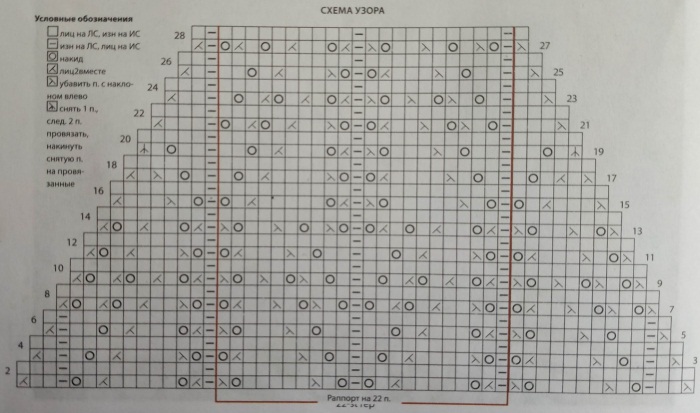
- Knit up to row 28 according to the pattern, then repeat everything from rows 1 to 28, then rows 1–14. There should be 144 loops left on the needles.
Transition to garter stitch knitting
- After the edge, 1 knit stitch, 2 together with one to the left, then knit with knit stitches to the openwork pattern. Before it, 2 loops of one, continue with the openwork pattern, 2 loops of one to the left. Then continue knitting with knit stitches. At the end, 2 loops of one, 2 knit stitches.
- After the edge, knit to the openwork pattern, then the openwork pattern and knit to the end.
- Repeat these 2 rows 32 times. There are 12 loops left in the purl row.
To finish knitting, you need to close 2 loops on each side. Fasten the remaining loop, cut the thread, hide the end in the product. Steam the shawl, spread it out and let it dry.
With a wavy pattern*
A knitted shawl, the diagram and description of which will help in the work, can be square in shape.
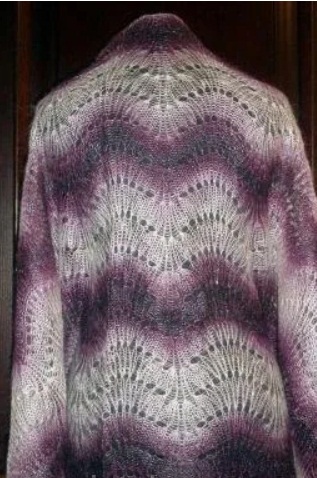
A popular and easy to perform wave pattern is knitted with a straight fabric. The accessory is convenient because it can be worn as a scarf, folded diagonally.
Materials and tools
- Goat down yarn with silk 300g, with long dyeing sections.
- Circular knitting needles size 6 mm.
- Markers.
Job Description
- For such a shawl, all the loops are cast on to the needles at once (242 loops). The number should be divisible by 24 plus 2 edge loops.
- Start with 4 rows of garter stitch (all rows knit stitch).
Wave pattern diagram: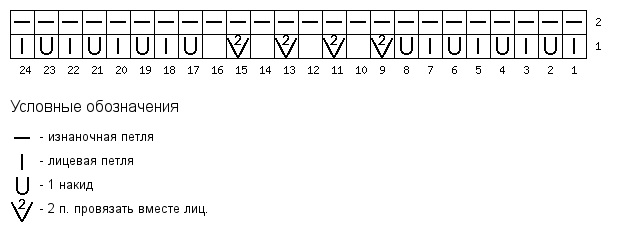
- After knitting the pattern according to the diagram, the next 6 rows should be knitted with the front surface (front loops on the face, back loops on the back side).
- From row 13, make a wavy pattern again and 6 rows of satin stitch.
- Continue knitting until square size.
- Finish with 4 rows of garter stitch. Close the stitches. Hide the yarn in the middle of the piece.
- If desired, the shawl can be finished with a scalloped edge around the entire perimeter.
- Soak the shawl for 15-20 minutes in a solution of shampoo and water, rinse, and squeeze lightly in a towel. Spread it out and straighten it out, fix it with pins at the edges. Dry it in this form.
When knitting a shawl with knitting needles, it is recommended to sit in a chair with armrests. This way, your arms will not get tired, having a point of support. In the conventional image, there are possible variations, both during the work and in the final completion of the shawl. The number of loops, the size of the product, the pattern of the border depend on the taste of the knitter. So you can get a completely unique thing, made with soul by your own hands.
Author: Korennik Olga Vasilievna
Article formatting: Vladimir the Great
Video about knitting a shawl with knitting needles
Knitted shawl "frozen leaves":
